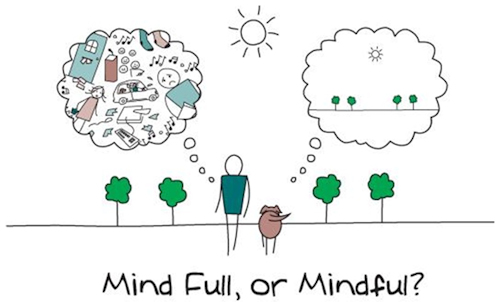TM
858-255-1812
Developing Leaders to Their Full Potential

 TM
TM
August, 2018
Mindfulness Taught by Man's Best Friend
By Dr. Wendy Arnold, M.D.
I love dogs. Currently, I do not have any furry babies, but I have thoughts about getting a dog. I also have particular thoughts about what a dog can teach humans. My first thought goes to Ivan Pavlov and what he taught us. He's the famous Russian physiologist that won a Nobel Prize for his understanding of behavior and classical conditioning. He did his work with dogs. He conducted a study where he conditioned dogs to salivate in the absence of food by ringing a bell. It was brilliant work that is well understood today in terms of behavior. But I want to explore his concepts in a different way. Instead of focusing on behavior, which is still brilliant and relevant, I want to compare his theory to mindfulness.
Mindfulness is one of the best ways to deal with stress in a positive way, but there are many skeptics. Those that don't understand ask how can a thought influence our body's physiology? Pavlov’s study is a perfect illustration of that exact possibility. His dogs learned to associate the sound of a bell with food. Despite the fact that no food is present, the dog is conditioned to salivate just because the bell triggers the thought of food. The salivary glands excrete saliva with a mere thought. Amazing when you realize that a physiological response happens not from reality but from a thought.
Apply this concept to a typical day. Many of us start the day with a stressful commute to work. If another driver does something annoying, it can effect the rest of the day negatively if you can't get it out of your mind. If you continue to relive the bad experience in your mind, your mind will continue to secrete stress hormones. Without a threat, these hormones can wear you out. Actively push this memory out of your mind so that it doesn't color your personal interactions throughout the day.
This mind control takes practice. A technique that I have learned to use is guided visualization. I create a still shot in my mind's eye of whatever incident that keeps intruding my thoughts. Then I envelope the image in a fluffy white cloud. I imagine pushing the cloud away with both hands. Sometimes I have to do that more than one time, but it works for me.
Another lesson the humble canine can teach us about mindfulness comes from their capacity to always live in the moment. They don't perseverate about the past or fret about the future. One minute they are agitated by the mailman encroaching on their territory, the next moment they return to playfully chewing a toy. The dog whisperer, Cesar Milan, uses this concept as one of the foundations for rehabilitating dogs that have learned bad behavior. His shows and books continually emphasize this disconnect between dogs and their humans. We think that they remember soiling the carpet, but the dog is confused by a person pushing his nose in the mess because it happened 10 minutes ago. If you don't catch a dog in the moment, it's difficult to correct its behavior.
Again, being in the moment takes practice. Another technique you can try is to change your environment, just a brief change to help reset it. For example, get up from your desk and go for a 5-minute walk, ideally outside. Fresh air and sunshine are simple, accessible refreshers. But even walking to a break room can help your mind shift gears. Even non-dog-owners know how excited dogs get when they know they're going for a walk.
My last thought about what dogs can teach us is that walking is good for you but even better if you can do it without a full mind.
DR. WAVE

My past Blogs are available for your convenience to access whenever you need to refer to this information. I'd love to hear from you if there is a subject matter you'd like me to address in future blogs.
- Dr. Wendy
- Dr. Wendy
|
Call
858-255-1812 |
|
Email
Wendy@DR-WAVE.com |
||

